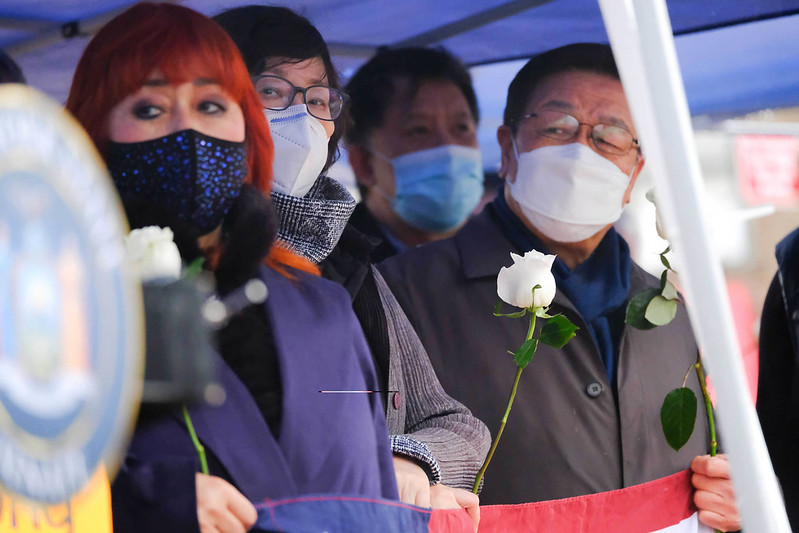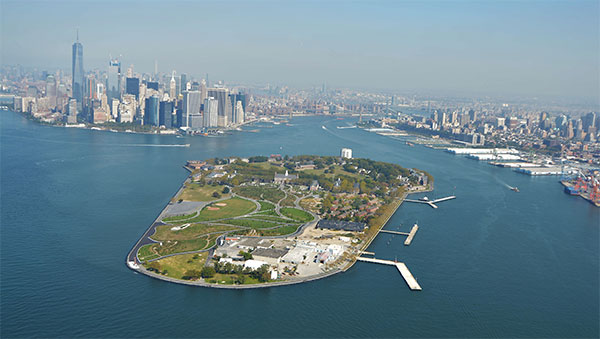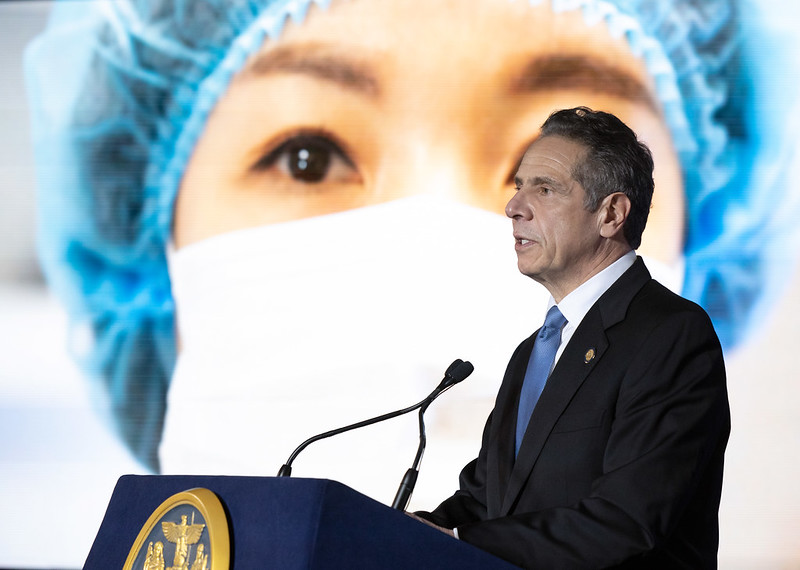Preventing Hate and Violence Against the Asian-American Community

Asian-American New Yorkers at a vigil (photo: Ed Reed/Mayoral Photography Office)
The shootings in Atlanta that took eight lives, destroyed eight futures, devastated and forever changed eight families, were at once heartbreaking, enraging, and if we are honest, predictable.
The violent deaths of eight people, including six Asian immigrant workers, was the result of a yearlong escalation of hatred and attacks on the Asian-American community, one which has accelerated in recent weeks but has been a constant presence, including here in our own city with our fellow New Yorkers experiencing violence for simply being Asian.
Atlanta is what happens when that festering bigotry builds in a nation with a demonic obsession with guns and an aversion to life-saving restrictions.
We need to disarm white supremacy.
Of course, we need common sense gun safety measures to combat weaponized white supremacy. At the same time, it’s not enough to limit access to guns themselves. The weapon is most dangerous when it’s fully loaded.
White supremacy gets ammunition when anti-Asian bigotry is encouraged by some, minimized by others, and largely ignored for years leading up to the pandemic, with incidents unreported but harm undeniable.
When the then-President of the United States spends a year using his position to not only fan the flames of this ignorance and hatred, but to ignite them from the most prominent podium in the nation.
And when the reaction to a shooting that targeted primarily Asian-American women is to center the shooter rather than the people whose lives he stole, to diminish the role of racism in this violence.
It does not require overt, intentional white supremacy or racism in order to perpetuate systems or advance ideas rooted in that ideology. Direct opposition, concrete action, is needed to disarm it.
The solution is not just to send more police - we don’t want to negate or minimize the sentiments of communities that are fearful and asking for further protection, but at the same time, police are not the only solution to the hatred that motivates these attacks, and while they can potentially provide some acute sense of security, they are not the long-term solution our city needs.
In 2019, the city began to fund the Hate Violence Prevention Initiative, a coalition of diverse community organizations designated by the City Council and charged with improving education and services in the city. In their first year, they began the invaluable work to serve the communities that are the most vulnerable to bias-motivated hate crimes. But last year, in the height of the pandemic, when Trump was seeding hatred of the Asian-American community, the city actually cut the budget for this initiative.
Now, it is a moral obligation and a governing imperative to not only restore the funding cut from this critical program, but to expand it. More resources and a broader scope will help to more fully recognize and include anti-Asian-American hate and violence prevention. It is only through a comprehensive initiative with a diverse array of voices in organizations that we will effectively combat hate.
One cannot hate neatly. That’s why it’s crucial for marginalized groups in all areas to stand with each other in the face of attacks, as Asian leaders stood up for Black lives last summer and as so many are standing with them today. In funding the Hate Violence Prevention Initiative and its associated groups, the city can get at the roots of bigotry, building stronger communities, and pushing back on prejudice.
As hard as it may be to admit and acknowledge, the violence we have seen was predictable. It should not take the deaths of our community members to listen to what we have been saying for years. But it is up to us to determine whether the next attack is preventable.
***
Jumaane Williams is Public Advocate for the City of New York. Jo-Ann Yoo is Executive Director of the Asian American Federation. On Twitter @JumaaneWilliams & @AAFederation.
***
Have an op-ed idea or submission for Gotham Gazette? Email This email address is being protected from spambots. You need JavaScript enabled to view it.
Governors Island’s Future Is Now

Governors Island (photo: Carlo Buscemi)
Governors Island is a 172-acre oasis that’s just a stone’s throw from the Statue of Liberty. But despite its position at the very heart of the five boroughs, most New Yorkers can’t locate it on a map. Closed off from the public for centuries, the island boasts a rich and little-known history. Thanks to two decades of progress, it's found new life as a summer escape for city dwellers, but its future has remained a question mark – until now.
The City Council is considering a plan by the Trust for Governors Island to rezone the southern half of the island. The proposal recognizes the existing parkland and makes possible new, year-round uses for an island that is currently accessible to the public only six months of the year. Enlivening these plans is a bold vision to create a Center for Climate Solutions, an ambitious plan to help our city emerge as a leader in solving the biggest existential crisis of our time.
It’s a long time coming, and builds on years of collaborative, community-based planning. In the mid-1990s, our predecessor organization, the Governors Island Alliance (now the Friends of Governors Island) came together as a group of more than 45 organizations to build consensus around a vision for Governors Island’s future. From our first meetings, which brought together hundreds of conservationists, urban planners, park managers, and community members, the shared vision for the island focused on turning a once off-limits federal facility into a place dedicated to public use and public benefit.
All along, any conversation about Governors Island’s future elicited a series of challenging questions. How to preserve and maximize this incredible resource for the public good? How to ensure a sustainable revenue stream that can support more public access along with the island’s massive infrastructure and transportation needs? How to attract new non-residential ways of utilizing a collection of aging former houses and barracks without turning them into private housing? After years of working to answer these questions, the Trust’s proposal represents a promising culmination.
Even in the early days, our planning and financial projections showed that new development was not only desirable but necessary to support year-round public visitation and generate a dedicated revenue stream to enhance public uses. To realize this goal, our first public workshop proposed that Governors Island become “a new kind of park containing a wide variety of attractions including hotels, educational facilities, museums, and arts and cultural centers.”
A few years later, the Trust’s predecessor organization was founded in 2004 with a mandate to create “an educational, recreational and cultural center that will offer a broad range of public uses.” Now, much of that initial vision has come to life: artists, thinkers, and urban farmers use the island as a creative workspace, 500 students attend a public high school there, and nearly a million New Yorkers enjoy the landmarked historic district and spectacular new 43-acre park each year.
Despite this progress, Governors Island remains a seasonal destination, inaccessible to the public from November through April. The two parcels contemplated by the proposed rezoning are fenced off from public use and filled with crumbling warehouses – a visible eyesore that detracts from the visitor experience of the park. Critics of the Trust’s plan have cynically argued that the zoning proposal paves the way for privatization. On the contrary, to deliver on the promise of creating a year-round public resource, investment and expanded partnerships are needed. The proposed educational, cultural and commercial uses – uses clearly defined by the federal deed restrictions as being in the public spirit – reflect two decades of planning studies and will be critical to animating the island year-round, as well as ensuring its long-term financial stability.
Of course, there should be guardrails in place, and the zoning should pay special attention to design guidelines, view and pedestrian corridors, and park-to-esplanade connection points. Public investments in the island’s parkland and historic district must be protected.
Those of us who love Governors Island know the magic of its hammocks, its scenic bike rides, its waterside cafés and its quirky cultural programming. The things that make this place so beloved are not going anywhere. Not a single acre of existing parkland will be touched under this plan – which will, in fact, add at least seven acres of public open space.
Anyone who visited Governors Island last summer felt the immediate benefit of this urban escape — like all of our parks, the island served as an extra lung for our city, giving us space to breathe and recharge. Now is the time to realize the full promise of this unique place and ensure that New Yorkers can enjoy the island’s magic 365 days a year. The proposed rezoning makes this possible. After two decades of planning, the future so many of us long envisioned for Governors Island has arrived.
***
Merritt Birnbaum is Executive Director of the Friends of Governors Island (former ly the Governors Island Alliance). Robert Pirani is a Board member of the Friends of Governors Island and was the Founding Executive Director of its predecessor organization, the Governors Island Alliance.
***
Have an op-ed idea or submission for Gotham Gazette? Email This email address is being protected from spambots. You need JavaScript enabled to view it.
The End of Toxic Male Leadership in New York

Gov. Cuomo (photo: governor's office)
Predatory behavior by powerful men towards women takes many forms. Flirting, demeaning, suppressing, touching, and more, are all manifestations of toxic male behavior that is too often normalized, even in some cases expected, by men in powerful positions. Clinton, Trump, Spitzer, Weiner, Schneiderman, and now, Cuomo — all male political titans who have faced allegations of sexual misconduct while holding high elected office.
Sadly, only a small fraction of sexual misconduct that takes place in and around the workplace, whether in politics or any other industry, makes it into the news. The media covers a story when it involves a high-profile man, but the vast majority of those incidents that are reported never end up with more than a slap on the offending man’s wrist and workplace seminars on office culture. Women, on the other hand, often lose their jobs, or decide they must leave, because of the trauma inflicted. When they come forward, they are shamed and harassed even more. Many are silenced via settlements, often having to make very difficult decisions under enormous pressure after suffering abuse.
As horrifying as predatory sexual behavior is in the workplace, it only scratches the surface of harm inflicted on women at work. Passive acceptance of male domination over companies and government is part of why we are where we are. Before the pandemic, women’s wages were still just 79 cents on the male dollar and just 62 cents on the male dollar for Black women. The wealth gap for women is even worse. Our stocks and bonds, equity stakes, and real estate interests represent just 32 cents on the male dollar and pennies for women of color.
Women leaders marry or start a family, as I did, and lose their jobs. When they keep them, they often lose power within their jobs because of how men respond to the change in women’s personal lives. They are denied equity in companies that they build, as I was, simply because male stakeholders value them less. Another Women’s History Month came and went, and women are no better off than we were before COVID-19. In fact we are falling even farther behind. It’s long past time to pull back the curtain and curb all patterns of abuse and privilege, because non-sexual workplace bias affects more women and is a main driver of gender inequity.
When Andrew Yang fired me from Manhattan GMAT days after I got married, I lost more than my financial livelihood. I had requested an equity stake in both of my salary negotiations and was denied. Yang got what I didn’t, and though I’d taken the founder’s concept and turned it into a multi-million-dollar company, Yang reaped the financial rewards of my sweat equity. Then he used my marriage as the reason he said I’d no longer be a good fit for the company, saying that I would want to focus on my new life and wouldn’t want to work as hard as I had. Andrew Yang also undercut my self-worth and dignity, my long-term potential for financial security, not to mention the toll that it took on a marriage that was only a few days old. I spoke publicly about what happened at a September 2019 public hearing of the New York City Commission on Gender Equity. When asked about my experience as he ran for president, Yang said I didn't have my facts straight, but offered no explanation for how he treated me.
But I am not the only woman to speak out about the way Andrew Yang and entities he has run have mistreated women. A woman who worked for the Manhattan test prep company after I left filed a lawsuit against Yang for pay inequity. Twice The New York Times published articles with credible information about other incidents of pay inequity and discomfort over workplace culture involving Yang. The first article appeared days before he exited the presidential race in February 2020. His record with women was also covered by the Times last month after hiring a political operative who acknowledged the likelihood of truth behind the allegations. In addition, multiple women have reported that Yang perpetuated a toxic atmosphere on the campaign trail. The “bro culture” reportedly traumatized a number of women, at least one of whom turned to mental health therapy to cope with its effect on her.
Most of the women affected by Yang and the workplace cultures he has created and overseen have been silenced via non-disclosure agreements, and the few of us who have spoken out about him publicly have been shamed, called liars, and threatened by Yang supporters. In one example of many, I was told in an email to “get off Andrew Yang’s ass, you entitled bitch,” and this person went on to suggest that I had been useless in the company. Surrogates of Yang on Twitter and Reddit call ed me and others desperate for attention, gold-diggers, stupid, and selfish. As any woman who has spoken out about a powerful man’s bad behavior knows, the abuse takes its toll and is long lasting.
As traumatic as it is, women must keep fighting, not only because of Andrew Cuomo or Andrew Yang, but because institutional biases continue to harm women, especially women of color. We have heard about the toll Cuomo’s abuse took on several young women whose careers were stunted by his behavior. At least one woman working on Yang’s presidential campaign explained how its toxic culture made her question her career path despite past success. Much of it speaks to the larger ‘old boys club’ mentality of politics that we must leave behind.
There is a wide continuum that must be addressed. More structurally, take as an example the decades-long New York City school nurse problem, which I have worked on as a parent and local education leader. Only one-third of school nurses, who are almost all women, are full-time salaried employees with the Department of Education; other nurses are on a waitlist for years to snatch up one of these coveted spots. School nurses employed by the Department of Health are paid hourly with a smaller benefits package and pension. And others are hired out via third-party vendors. Few are paid a true living wage considering the cost of living in the neighborhoods where they serve. The decision-makers who created this unjust structure and those who are in a position to fix it, but haven’t, are almost always men. School nurses are an essential component to the Department of Education, and the women who serve in this role have been disrespected and underpaid for long enough.
Gaps in maternity leave, child care, and elder care, massive and persistent pay and wealth gaps, lack of retirement security, and insufficient work/life balance expectations continue to undermine women in the workplace. Women -- and our male allies -- need to fight for our future because if men keep monopolizing decisions in New York and around the country, current inequities will worsen, leaving another generation of women behind.
As New York reckons with Andrew Cuomo’s abuse and those who have enabled it, as well as many other men in New York politics who have mistreated women, we should also look closely at Andrew Yang’s track record given the position of immense power he is now seeking.
Cuomo should have already heeded the many calls for him to resign over his bad behavior, and we must also say goodbye to the many other men in politics and other industries who abuse women and perpetuate vast gender imbalances. If we are serious about preventing discriminatory workplaces that foster bias against women, we should closely examine workplace patterns among all candidates for elected office. Based on the track record reported by multiple women, calls for Yang to pull out of the mayor's race should follow. We can’t afford any more toxic male leadership.
***
Kim Watkins is a Harlem parent, president of Community Education Council, District 3, a founding member of Parents Supporting Parents, and a Democratic candidate for Manhattan Borough President. On Twitter at @kimwatkinsnyc.
***
Have an op-ed idea or submission for Gotham Gazette? Email This email address is being protected from spambots. You need JavaScript enabled to view it.




